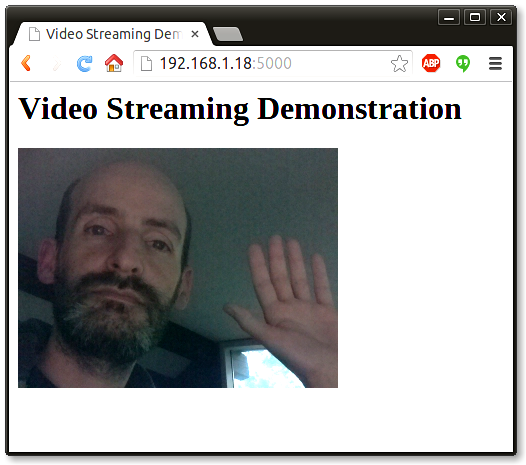Video Streaming with Flask
Posted by
on underI'm sure by now you know that I have released a book and a couple of videos on Flask in cooperation with O'Reilly Media. While the coverage of the Flask framework in these is fairly complete, there are a small number of features that for one reason or another did not get mentioned much, so I thought it would be a good idea to write articles about them here.
This article is dedicated to streaming, an interesting feature that gives Flask applications the ability to provide large responses efficiently partitioned in small chunks, potentially over a long period of time. To illustrate the topic I'm going to show you how to build a live video streaming server!
NOTE: there is now a follow-up to this article, Flask Video Streaming Revisited, in which I describe some improvements to the streaming server introduced here.
What is Streaming?
Streaming is a technique in which the server provides the response to a request in chunks. I can think of a couple of reasons why this might be useful:
- Very large responses. Having to assemble a response in memory only to return it to the client can be inefficient for very large responses. An alternative would be to write the response to disk and then return the file with
flask.send_file(), but that adds I/O to the mix. Providing the response in small portions is a much better solution, assuming the data can be generated in chunks. - Real time data. For some applications a request may need to return data that comes from a real time source. A pretty good example of this is a real time video or audio feed. A lot of security cameras use this technique to stream video to web browsers.
Implementing Streaming With Flask
Flask provides native support for streaming responses through the use of generator functions. A generator is a special function that can be interrupted and resumed. Consider the following function:
def gen():
yield 1
yield 2
yield 3
This is a function that runs in three steps, each returning a value. Describing how generator functions are implemented is outside the scope of this article, but if you are a bit curious the following shell session will give you an idea of how generators are used:
>>> x = gen()
>>> x
<generator object gen at 0x7f06f3059c30>
>>> next(x)
1
>>> next(x)
2
>>> next(x)
3
>>> next(x)
Traceback (most recent call last):
File "<stdin>", line 1, in <module>
StopIteration
You can see in this simple example that a generator function can return multiple results in sequence. Flask uses this characteristic of generator functions to implement streaming.
The example below shows how using streaming it is possible to generate a large data table, without having to assemble the entire table in memory:
from flask import Response, render_template
from app.models import Stock
def generate_stock_table():
yield render_template('stock_header.html')
for stock in Stock.query.all():
yield render_template('stock_row.html', stock=stock)
yield render_template('stock_footer.html')
@app.route('/stock-table')
def stock_table():
return Response(generate_stock_table())
In this example you can see how Flask works with generator functions. A route that returns a streamed response needs to return a Response object that is initialized with the generator function. Flask then takes care of invoking the generator and sending all the partial results as chunks to the client.
For this particular example if you assume Stock.query.all() returns the result of a database query as an iterable, then you can generate a potentially large table one row at a time, so regardless of the number of elements in the query the memory consumption in the Python process will not grow larger and larger due to having to assemble a large response string.
Multipart Responses
The table example above generates a traditional page in small portions, with all the parts concatenated into the final document. This is a good example of how to generate large responses, but something a little bit more exciting is to work with real time data.
An interesting use of streaming is to have each chunk replace the previous one in the page, as this enables streams to "play" or animate in the browser window. With this technique you can have each chunk in the stream be an image, and that gives you a cool video feed that runs in the browser!
The secret to implement in-place updates is to use a multipart response. Multipart responses consist of a header that includes one of the multipart content types, followed by the parts, separated by a boundary marker and each having its own part specific content type.
There are several multipart content types for different needs. For the purpose of having a stream where each part replaces the previous part the multipart/x-mixed-replace content type must be used. To help you get an idea of how this looks, here is the structure of a multipart video stream:
HTTP/1.1 200 OK
Content-Type: multipart/x-mixed-replace; boundary=frame
--frame
Content-Type: image/jpeg
<jpeg data here>
--frame
Content-Type: image/jpeg
<jpeg data here>
...
As you see above, the structure is pretty simple. The main Content-Type header is set to multipart/x-mixed-replace and a boundary string is defined. Then each part is included, prefixed by two dashes and the part boundary string in their own line. The parts have their own Content-Type header, and each part can optionally include a Content-Length header with the length in bytes of the part payload, but at least for images browsers are able to deal with the stream without the length.
Building a Live Video Streaming Server
There's been enough theory in this article, now it is time to build a complete application that streams live video to web browsers.
There are many ways to stream video to browsers, and each method has its benefits and disadvantages. The method that works well with the streaming feature of Flask is to stream a sequence of independent JPEG pictures. This is called Motion JPEG, and is used by many IP security cameras. This method has low latency, but quality is not the best, since JPEG compression is not very efficient for motion video.
Below you can see a surprisingly simple, yet complete web application that can serve a Motion JPEG stream:
#!/usr/bin/env python
from flask import Flask, render_template, Response
from camera import Camera
app = Flask(__name__)
@app.route('/')
def index():
return render_template('index.html')
def gen(camera):
while True:
frame = camera.get_frame()
yield (b'--frame\r\n'
b'Content-Type: image/jpeg\r\n\r\n' + frame + b'\r\n')
@app.route('/video_feed')
def video_feed():
return Response(gen(Camera()),
mimetype='multipart/x-mixed-replace; boundary=frame')
if __name__ == '__main__':
app.run(host='0.0.0.0', debug=True)
This application imports a Camera class that is in charge of providing the sequence of frames. Putting the camera control portion in a separate module is a good idea in this case, this way the web application remains clean, simple and generic.
The application has two routes. The / route serves the main page, which is defined in the index.html template. Below you can see the contents of this template file:
<html>
<head>
<title>Video Streaming Demonstration</title>
</head>
<body>
<h1>Video Streaming Demonstration</h1>
<img src="{{ url_for('video_feed') }}">
</body>
</html>
This is a simple HTML page with just a heading and an image tag. Note that the image tag's src attribute points to the second route of this application, and this is where the magic happens.
The /video_feed route returns the streaming response. Because this stream returns the images that are to be displayed in the web page, the URL to this route is in the src attribute of the image tag. The browser will automatically keep the image element updated by displaying the stream of JPEG images in it, since multipart responses are supported in most/all browsers (let me know if you find a browser that doesn't like this).
The generator function used in the /video_feed route is called gen(), and takes as an argument an instance of the Camera class. The mimetype argument is set as shown above, with the multipart/x-mixed-replace content type and a boundary set to the string "frame".
The gen() function enters a loop where it continuously returns frames from the camera as response chunks. The function asks the camera to provide a frame by calling the camera.get_frame() method, and then it yields with this frame formatted as a response chunk with a content type of image/jpeg, as shown above.
Obtaining Frames from a Video Camera
Now all that is left is to implement the Camera class, which will have to connect to the camera hardware and download live video frames from it. The nice thing about encapsulating the hardware dependent part of this application in a class is that this class can have different implementations for different people, but the rest of the application remains the same. You can think of this class as a device driver, which provides a uniform implementation regardless of the actual hardware device in use.
The other advantage of having the Camera class separated from the rest of the application is that it is easy to fool the application into thinking there is a camera when in reality there is not, since the camera class can be implemented to emulate a camera without real hardware. In fact, while I was working on this application, the easiest way for me to test the streaming was to do that and not have to worry about the hardware until I had everything else running. Below you can see the simple emulated camera implementation that I used:
from time import time
class Camera(object):
def __init__(self):
self.frames = [open(f + '.jpg', 'rb').read() for f in ['1', '2', '3']]
def get_frame(self):
return self.frames[int(time()) % 3]
This implementation reads three images from disk called 1.jpg, 2.jpg and 3.jpg and then returns them one after another repeatedly, at a rate of one frame per second. The get_frame() method uses the current time in seconds to determine which of the three frames to return at any given moment. Pretty simple, right?
To run this emulated camera I needed to create the three frames. Using gimp I've made the following images:



Because the camera is emulated, this application runs on any environment, so you can run this right now! I have this application all ready to go on GitHub. If you are familiar with git you can clone it with the following command:
$ git clone https://github.com/miguelgrinberg/flask-video-streaming.git
If you prefer to download it, then you can get a zip file here.
Once you have the application installed, create a virtual environment and install Flask in it. Then you can run the application as follows:
$ python app.py
After you start the application enter http://localhost:5000 in your web browser and you will see the emulated video stream playing the 1, 2 and 3 images over and over. Pretty cool, right?
Once I had everything working I fired up my Raspberry Pi with its camera module and implemented a new Camera class that converts the Pi into a video streaming server, using the picamera package to control the hardware. I will not discuss this camera implementation here, but you can find it in the source code in file camera_pi.py.
If you have a Raspberry Pi and a camera module you can edit app.py to import the Camera class from this module and then you will be able to live stream the Pi camera, like I'm doing in the following screenshot:

If you want to make this streaming application work with a different camera, then all you need to do is write another implementation of the Camera class. If you end up writing one I would appreciate it if you contribute it to my GitHub project.
Limitations of Streaming
When the Flask application serves regular requests the request cycle is short. The web worker receives the request, invokes the handler function and finally returns the response. Once the response is sent back to the client the worker is free and ready to take on another request.
When a request that uses streaming is received, the worker remains attached to the client for the duration of the stream. When working with long, never ending streams such as a video stream from a camera, a worker will stay locked to the client until the client disconnects. This effectively means that unless specific measures are taken, the application can only serve as many clients as there are web workers. When working with the Flask application in debug mode that means just one, so you will not be able to connect a second browser window to watch the stream from two places at the same time.
There are ways to overcome this important limitation. The best solution in my opinion is to use a coroutine based web server such as gevent, which Flask fully supports. With the use of coroutines gevent is able to handle multiple clients on a single worker thread, as gevent modifies the Python I/O functions to issue context switches as necessary.
Conclusion
In case you missed it above, the code that supports this article is this GitHub repository: https://github.com/miguelgrinberg/flask-video-streaming/tree/v1. Here you can find a generic implementation of video streaming that does not require a camera, and also an implementation for the Raspberry Pi camera module. This follow-up article describes some improvements I made after this article was published originally.
I hope this article shed some light on the topic of streaming. I concentrated on video streaming because that is an area I have some experience, but streaming has many more uses besides video. For example, this technique can be used to keep a connection between the client and the server alive for a long time, allowing the server to push new information the moment it becomes available. These days the Web Socket protocol is a more efficient way to achieve this, but Web Socket is fairly new and works only in modern browsers, while streaming will work on pretty much any browser you can think of.
If you have any questions feel free to write them below. I plan to continue documenting more of the not well known Flask topics, so I hope you connect with me in some way to know when more articles are published. I hope to see you in the next one!
Miguel
-
#376 JP g said
Sorry, I did not describe it correctly. I use opencv and the camera stops when the user brings his face in some certain dimension from the camera. So, the time that the camera stops depends on the user. That means, the time varies. So, I must somehow pass this time from python in html file, right? Where can I return this value in your above code? I' ve put the checking of time inside the while loop of gen function, from which I break. I tried some things, but I'm doing them the wrong way. What can you suggest?
-
#377 Miguel Grinberg said
@JP: Then the client can regularly ask the server if it is time to stop using a asynchronous request. Or you can also use a WebSocket or Socket.IO connection, with which the server can tell the client to stop directly without the client having to ask.
-
#378 palbha said
Hi , i have followed the above code and it works well if i have only one video to be displayed if i have two web pages showing different videos it show error anyway to avoid the same
-
#379 Miguel Grinberg said
@palbha: what's the error that you get? How did you get two different streams into the application?
-
#380 ASHISH BHARADWAJ said
Hi @Miguel I want to stream the video to multiple clients. What steps should I have to follow? Right now What happens one client can access the camera but another client is going to see only HTML.
-
#381 Miguel Grinberg said
@ASHISH: which web server are you using? You need one that supports multiple threads to serve multiple clients at the same time.
-
#382 Moltas said
I don't understand what you should write in index.html at this location:
<img src="{{ url_for('video_feed') }}">
could you please explain it? -
#383 Miguel Grinberg said
@Moltas: See the link to the code on GitHub. This is 100% complete code that you can run on your computer and study.
-
#384 Q said
To save someone a few minutes:
Python 2:
x = gen()
x.next()Python 3:
x = gen()
x.next() -
#385 Miguel Grinberg said
@Q: I missed that, it should have been updated long ago. A best option is to do next(x) which works with Python 2 and 3.
-
#386 ozer said
Its work great thank you.
But I have question, When I pre process the image I need to send it to again web page. I mean, I try to read digits from camera and when ı did it ı need to print it in the same below the camera. How can Do it ?
For examle all ı need web page like this
[ camera ]
[ Read Digits ] // This come from python scripts
Thank you very much...
-
#387 Miguel Grinberg said
@ozer: this is not related to this project, what you need to do is to modify the image that you receive from the camera using a library such as pillow or similar.
-
#388 Prerit said
Miguel!!Thanks for your valuable explanation on this topic.
Can we use web cam of a laptop as a video source.
-
#389 Miguel Grinberg said
@Prerit: probably, using the OpenCV camera class that I have in the GitHub repository.
-
#390 Denson George said
Miguel , For some reason I need to keep reloading the page for the image to change?
Is there a need to use ajax? Since you have mentioned it's a video stream I assumed this is not required? -
#391 Miguel Grinberg said
@Denson: it could be a problem with your browser, the support for Motion JPEG video streams is old, not sure how much attention browsers pay to it.
-
#392 noodleVSwater said
Your article is very helpful to me, thank you, and I also encountered a trouble, I have used gevent running flask, video screen is also normal display, but I have a "screenshot" button on the page, click it will send a http request using axios to the service side, However, the browser to view the request has been in the "pending" state, the server did not receive, only close the browser will receive the request, expect your guidance.
-
#393 Miguel Grinberg said
@noodleVSwater: I can only guess without seeing your code, but what's probably happening is that your stream handler is blocking, so no other thing can run under gevent. Have you monkey patched the standard library? That helps sometimes.
-
#394 noodleVSwater said
Thank you for your suggestion, I found the reason in your sample code, use “gevent” must be used for the camera to turn on the thread, otherwise it will cause blocking, but strangely, directly using “app.run(debug=true)” to run the app, can accept the request normally, It seems like you're running with “manage” and “gevent” packaging, and not using threads will cause it to fail, but thankfully, I've solved the trouble now, haha, and finally thank you very much!
-
#395 Miguel Grinberg said
@noodleVSwater: when you use app.run() you are running in "threading" mode, which does not support WebSocket. It is true that blocking is less of a problem in threading, but not having WebSocket is a pretty high cost.
-
#396 Donato said
HiI knpw a few year are passed since you wrote this article, but I followed your guide without success. I'm using windows 10. Once I download flask-video-streaming-1 from you link and unzip it, how can I install it? I have already installed via pip flask and camera, and I've checked by prompr that they can be imported correctly.
One more thing. I need to stream a video provided by an IP camera, and I have checked with VLC the rtsp ink. How should I modify the script and how can I change the port to call (http://localhost:5000)?
Thanks a lot -
#397 Miguel Grinberg said
@Donato: the article explains how to run the application. The main file is called app.py. This code is for Motion JPEG streaming. It does not work with RTSP.
-
#398 Syam said
Hi, Thank you for a nice tutorial.
I'm just wondering is there any way to increase FPS? I'm using raspberry pi camera to stream video. -
#399 Miguel Grinberg said
@Syam: this was asked several times above. You need either a faster network, faster computer and/or smaller frames.
-
#400 var said
The video stream works fine for few minutes but after that there is a significant lag , how can it be reduced?



